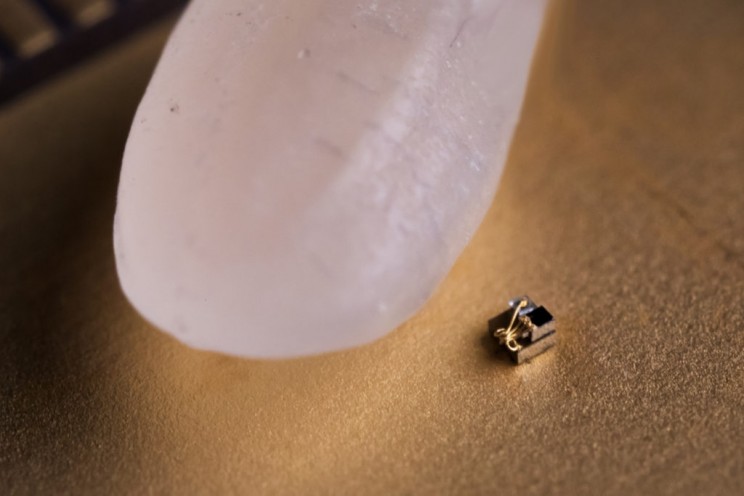
“World’s smallest computer” is a sensor smaller than a grain of sand.
The title of “world’s smallest computer” is a contentious one – and not just because scientists are racing to shrink devices, but because the very definition of a computer could be up for debate. The latest team to lay claim to the title is from the University of Michigan, with a tiny device that communicates through light and makes a grain of rice look gigantic.
The new device is essentially a cube with sides measuring just 0.3 mm (0.01 in) each, making it about a tenth of the size of the previous world’s smallest computer: A sand-grain-sized device that IBM unveiled back in March.
Onboard the tiny device is a processor, RAM, a photovoltaic power system, and a wireless transmitter and receiver that communicates using pulses of light. A base station beams light to the chip to power it, and the chip sends data back to base as light using a transmission LED. It might sound like a recipe for disaster to use light as both power and data, but the computer has been designed around that problem, with the team using switched capacitors instead of light-sensitive diodes, for example.
The tiny computer is designed to be used as a precision temperature sensor, able to monitor temperatures and changes in regions as small as a few cells, precise to about 0.1° C. It does so by converting temperatures into time intervals, and comparing that to a steady time interval transmitted to the chip by the base station.
While this mechanism could have a range of applications, one of the first might be in cancer detection and treatment. The hypothesis is that cancer cells are generally hotter than healthy tissue, so researchers plan to put that idea to the test using this precise temperature sensor.
“Since the temperature sensor is small and biocompatible, we can implant it into a mouse and cancer cells grow around it,” says Gary Luker, a collaborator on the project. “We are using this temperature sensor to investigate variations in temperature within a tumor versus normal tissue and if we can use changes in temperature to determine success or failure of therapy.”
Another point of contention is whether a sensor like this still warrants the label of “computer,” and by extension the world’s smallest computer. For example, as soon as the device loses power, all of its programming and data are wiped, which the team says might rule it out from the term. That could be particularly problematic given it’s powered by light from an external base station, and will be operating in dark environments like the human body.
“We are not sure if they should be called computers or not,” says David Blaauw, lead developer of the device. “It’s more of a matter of opinion whether they have the minimum functionality required.”
Whatever you want to call it, these tiny devices could eventually find use in biomedical diagnosis and monitoring, surveillance, studying tiny organisms, and monitoring oil reservoirs.
The research was presented at the 2018 Symposia on VLSI Technology and Circuits last week.













